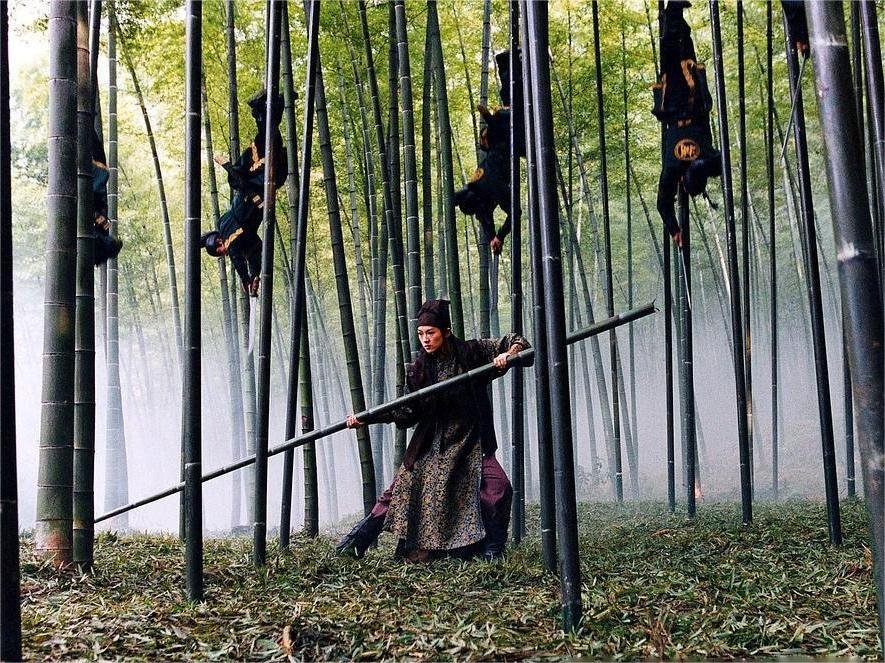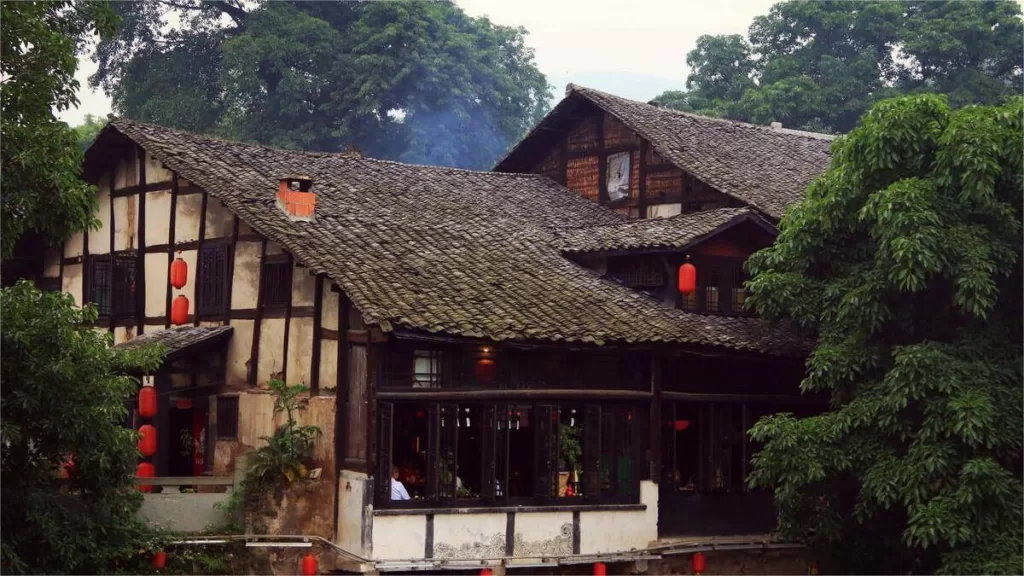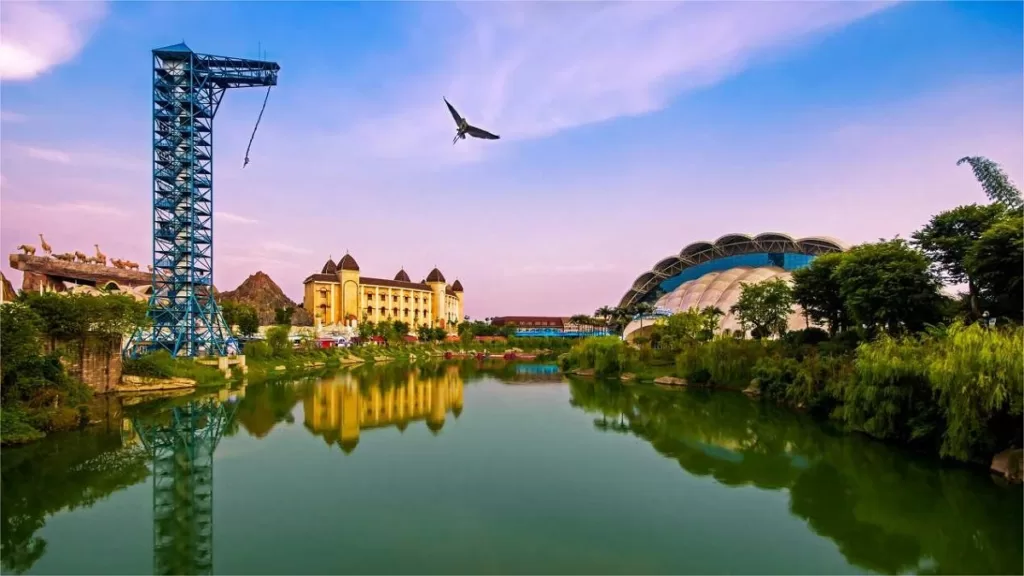Nestled in the heart of Chongqing, the Tea Mountain Bamboo Sea (重庆茶山竹海) is a sprawling expanse of verdant sub-tropical evergreen broadleaf forests covering a total area of 9,979 hectares. This breathtaking destination boasts a staggering 97% forest coverage, predominantly composed of bamboo and tea trees, creating the illusion of an endless sea, earning it the charming nickname “Tea Mountain Bamboo Sea.”
This enchanting natural haven is a testament to the harmonious coexistence of tea and bamboo, where more than 30 varieties of tea flourish, producing renowned teas like “Yongchuan Xiuya,” “Yudou Haocha,” and “Yuzhou Maofeng.” Additionally, the area features over ten different species of bamboo, including hairy bamboo, kind bamboo, bitter bamboo, and white-interlaced bamboo.
The region’s climate is temperate, offering distinct seasons throughout the year. With abundant rainfall all year round, the highest temperatures during July and August rarely exceed 30 degrees Celsius, and even in November and December, the lowest temperatures seldom dip below 0 degrees Celsius. It’s a place where you can experience light snowfall in late December and early January, adding an extra layer of beauty to the scenery.
Table of Contents
- Basic Information
- Location and transportation
- Map of Tea Mountain Bamboo Forest
- Highlights of Tea Mountain Bamboo Forest
- Vlog about Tea Mountain Bamboo Sea
- Useful Tips Summarized from Reviews
- Other Attractions in Yongchuan District
Basic Information
| Estimated Length of Tour | A day |
| Ticket Price | Free |
| Opening Hours | 9.00 – 18.00; Last admission: 17.00 |
| Telephone Number | 0086-023-49785809; 0086-023-49785801 |
Location and transportation
Tea Mountain Bamboo Forest is situated in the Jiashan Mountain Range within the administrative boundaries of Yongchuan District in Chongqing, China. Its precise geographical coordinates range from approximately east longitude 106°2’02” to 106°03’54” and north latitude 29°22’26” to 29°31’54”. The location is approximately 55 kilometers to the east of Chongqing’s city center.
Getting to Tea Mountain Bamboo Sea from Chongqing’s main city center is a relatively straightforward journey. Here’s how you can reach this picturesque destination:
From Chongqing City Center to Yongchuan:
- You can catch buses from several major bus stations in Chongqing to Yongchuan. Buses typically depart frequently throughout the day. Consider heading to Chongqing Caiyuanba Bus Station, Chenjiaping Bus Station, or Chaotianmen Bus Station. The bus fare for this route is approximately around 28 Chinese Yuan.
- During holidays and peak travel seasons, you can also find direct tourist buses from these stations to Tea Mountain Bamboo Sea and other attractions like Chongqing Wildlife World.
From Yongchuan to Tea Mountain Bamboo Sea:
- Once you arrive in Yongchuan, you’ll find that transportation to Tea Mountain Bamboo Sea is quite convenient. There are several options available.
- Public buses such as 118A, 118B, 121, and others provide access to the scenic area. Simply board one of these buses, and they will take you to your destination.
- Alternatively, you can opt for a taxi, which will cost you approximately 25-40 Chinese Yuan, depending on the precise location within Yongchuan and the current rates.
Map of Tea Mountain Bamboo Forest

Highlights of Tea Mountain Bamboo Forest
Thin Knife Ridge

One of the most remarkable peaks in this magnificent area is the Thin Knife Ridge (Bo Dao Ling,薄刀岭), which stands as the highest point of Jishan Mountain and western part of Chongqing, with the main peak reaching an elevation of 1,025 meters and the second peak at 1,016 meters. Thin Knife Ridge’s steep and majestic form with its sharp, knife-edge appearance, which is less than a meter wide at its narrowest point, offers panoramic views of Chongqing’s iconic peaks, including Jinyun Mountain, Gele Mountain, Wenquan Mountain, and Zhongliang Mountain. The city of Yongchuan can also be seen in the distance from the summit.
Zhude Tea House

Nestled within the Tea Mountain Bamboo Sea, you’ll find the Zhude Tea House (朱德品茶楼). Located within the Chongqing Tea Research Institute, this charming house is surrounded by lush tea plantations. The architecture features a distinctive blend of traditional and Western elements with its small, tiled roof, and a brick structure. The teahouse spans two floors, measuring 9.3 meters deep and 10.7 meters wide, covering a total area of 99.51 square meters. In April 1963, at the age of 77, the revered Chinese Communist leader Zhu De once enjoyed Yongchuan’s famous tea at this very establishment, hence its name, “Zhude Tea House.”
Filming Location

Tea Mountain Bamboo Sea has also become a popular filming location, renowned for its stunning natural beauty. Two notable sites are Fanziwan Bamboo Sea (扇子湾竹海) and Jinpen Lake Bamboo Sea (金盆湖竹海). These locations served as the exclusive outdoor filming spots for the Chinese blockbuster film “House of Flying Daggers” (十面埋伏). The bamboo forests of Fanziwan are so dense that they seem to pierce the sky, making it a dramatic and challenging location to shoot. In 2003, director Zhang Yimou selected this area for his cinematic masterpiece, and the site has since become an attraction for visitors who want to relive the magic of the movie.
Tianzi Palace Ruins

The Tea Mountain Bamboo Sea is rich in history, and its most profound historical relic is the Tianzi Palace Ruins (天子殿遗址), located at the summit of Yunding Mountain, which has an elevation ranging from 950 to 980 meters and is surrounded by sheer cliffs. The Tianzi Palace was originally a strategic stronghold and command center for the leader of the White Lotus Sect during the Qing Dynasty in the sixth year of Jiaqing (1801). The site is protected by four stonewall fortifications known as “Xuanwu Gate,” “Yong’an Gate,” “Xuanwei Gate,” and “Tianbao Gate,” all constructed in strategically vital positions. Local residents also referred to this stronghold as “Mugua Village.” The Tianzi Palace Ruins bear witness to a significant period in Chinese history and offer a window into the region’s cultural heritage.
Vlog about Tea Mountain Bamboo Sea
Useful Tips Summarized from Reviews
Take the Shuttle Bus: It’s highly recommended to purchase round-trip tickets for the shuttle bus from the tourist center. The round-trip fare is 25 yuan per person. The tourist center is approximately 20 kilometers from the mountain, and the bus ride takes about half an hour. Along the way, the bus can stop anywhere upon request, making it very convenient. The last bus usually departs around 5:30 PM, so it’s advisable to arrive early and catch the last bus back down.
Use Restrooms at the Entrance: There are no restroom facilities on the mountain itself, so it’s best to utilize the restroom facilities at the entrance before starting the ascent.
Prepare for Insects: While the bamboo forest offers a cool breeze, there are still many mosquitoes, and sightings of grasshoppers are common. It’s recommended to bring insect repellent to ward off mosquitoes and other insects.
Follow the Crowd Up the Mountain: There’s only one main path leading up the mountain, so simply follow the crowd. However, on the descent, there are several paths to choose from. Along the way, there will be signposts indicating various routes, some longer and some shorter. Visitors should choose according to their fitness level and preferences.
Bring Sufficient Water: It’s important to bring an adequate supply of drinking water, as there are only two shops along the way where water can be purchased.





When traveling from Shapingba in Chongqing to the Tea Mountain Bamboo Sea, taking a second-class high-speed train costs around 30 yuan. Arrive at Yongchuan East Station around 8 a.m. (Taking the high-speed train only takes about 20 minutes, much faster than the light rail.) Take a taxi to the Yongchuan Tea Mountain Bamboo Sea Tourist Transfer Center, which costs around 10 yuan. Purchase a round-trip shuttle bus ticket for 25 yuan (highly recommended, as it is about 20 kilometers away… Read more »